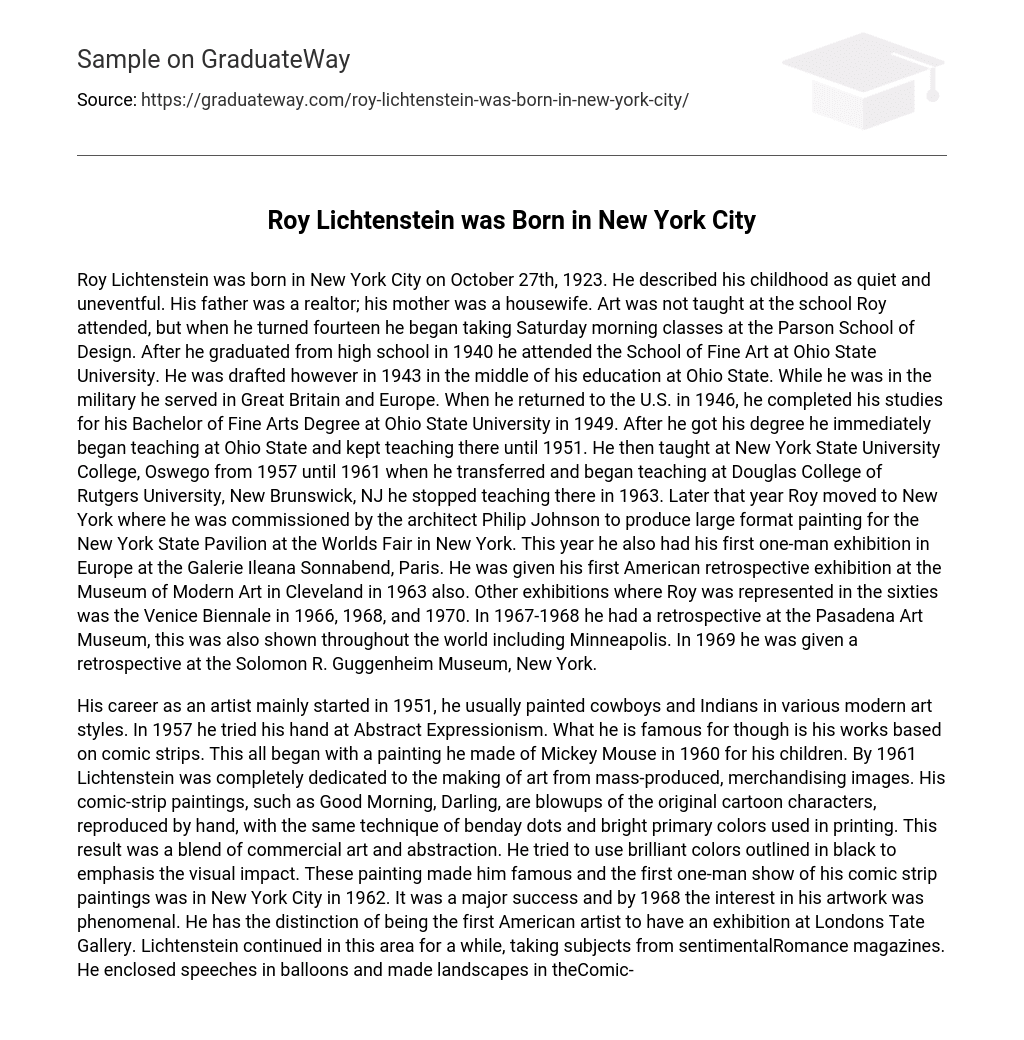Roy Lichtenstein, born on October 27th, 1923 in New York City, had a quiet childhood. His father worked as a realtor and his mother was a housewife. Despite attending a school that did not offer art classes, Lichtenstein took up classes at the Parson School of Design when he was fourteen. After graduating from high school in 1940, he pursued a Fine Art degree at Ohio State University. However, in 1943, Lichtenstein was drafted and served in Great Britain and Europe during his military service. Upon returning to the US in 1946, he completed his studies for his Bachelor of Fine Arts Degree at Ohio State University by 1949. He then began teaching positions starting with Ohio State until 1951. Later on, he taught at New York State University College Oswego from 1957 to 1961 and eventually at Douglas College of Rutgers University in New Brunswick, NJ.
In 1963, Lichtenstein moved to New York where architect Philip Johnson commissioned him to create large format paintings for the New York State Pavilion at the World’s Fair.During this same year, he had his first solo exhibition in Europe at Galerie Ileana Sonnabend in Paris.Additionally,Lichtenstein’s first American retrospective exhibition took place at the Museum of Modern Art in Cleveland also in that yearDuring the 1960s, Roy Lichtenstein’s artwork was widely exhibited, with his participation in the Venice Biennale in 1966, 1968,and1970.In addition, his work was featured in a retrospective at the Pasadena Art Museum from 1967 to 1968. This exhibition later traveled to various locations, including Minneapolis. Moreover, he received another prestigious accolade in 1969 with a retrospective at the Solomon R. Guggenheim Museum in New York.
The artist began his career in 1951, painting cowboys and Indians in various modern art styles. However, in 1957, he shifted to Abstract Expressionism. But it was his paintings based on comic strips that ultimately brought him fame. It all started with a painting of Mickey Mouse in 1960 for his children. In 1961, Lichtenstein fully dedicated himself to creating art from mass-produced merchandising images.
His comic-strip paintings, like Good Morning, Darling, were enlarged versions of original cartoon characters reproduced by hand using the benday dots technique and vibrant primary colors commonly used in printing. This fusion of commercial art and abstraction became his signature style. By emphasizing visual impact through brilliant colors outlined in black, these paintings propelled him to fame.
In 1962, New York City hosted his successful first solo exhibition of comic strip paintings. The demand for his artwork reached extraordinary levels by 1968. Notably, during this period Lichtenstein became the first American artist to have an exhibition at the Tate Gallery in London.
He also explored subjects from sentimental romance magazines while integrating speech balloons and creating comic-book style landscapes. Additionally, he experimented with making statues that emulated comic strip effects.During the 1970s and ’80s, the artist’s studio transformed into a production center with assistants helping to create various versions of his artwork. This phase marked a departure from minimal brushwork, focusing instead on landscapes and still lifes. Inspired by Picasso and other painters, he embraced experimental techniques like cubism. Despite a busy schedule, he continued to produce paintings, sculptures, and prints. Exhibitions during this time included retrospectives of his drawings in Paris and Berlin in 1975, as well as a public commission for a sculpture in Miami Beach in 1979. Notable series included “American Indians.” In 1981, his retrospective toured several countries including the US, Europe, and Japan. He also rented a loft in New York City to complement his Southampton studio in 1982. In 1985, he completed a mural for the Equitable Center in New York. Two years later saw another retrospective exhibition featuring his drawings at both the Museum of Modern Art in New York and the Kunsthalle Frankfurt.
In the 1990s, he produced several paintings and artworks, including a series of Chinese-style Landscapes. Tragically, he died in Manhattan on Monday, September 29th, 1997 at seventy-three years old.
“He didn’t need to sign documents because his unique style was his signature. Lichtenstein had the ability to turn any ordinary object such as an apple on a table, a goldfish in a bowl, or the reflection of a mirror into a work of art bearing his distinctive Lichtenstein touch. He continuously improved and refined his craft, establishing himself as a remarkable painter. He was a self-sufficient force in the art world, epitomizing the spirit of American creativity, and his absence is already felt.”





